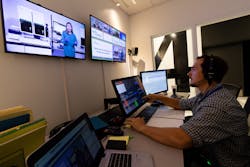Virtually uninterrupted: A virtual learning success
Until the COVID-19 pandemic, many laboratories depended on the classic train-the-trainer model for teaching staff how to operate their new instruments. Select laboratorians were sent to a vendor’s location to receive the training necessary. Pressured to know everything from system operations to maintenance to troubleshooting, these laboratorians were responsible for the transfer of knowledge to their coworkers, for the life of that system.
The train-the-trainer model has its limitations. The laboratorian sent to training may have learned a great deal but may fail as a trainer. Can he or she explain both the what and the how in a meaningful and understandable manner? Can he or she teach concepts to those with varying levels of experience and understanding? Coworkers may not feel comfortable asking questions or sharing ideas. Overall, the model can be a very difficult and time-consuming process.
- Pre-COVID, 90% of the training for Sysmex’s service, scientific applications, and technical assistance center associates was conducted in person. The curriculum was completely reinvented to VILT in just a few weeks to ensure no interruption in customer service.
- Sales associates were no longer allowed in hospitals to meet their customers’ needs, so sales associates conducted virtual demonstrations, presentations, and symposia, allowing healthcare staff to remain in their laboratories with minimal disruption.
- An advanced training course for laboratorians, previously offered only face-to-face, was broken into two-hour increments for delivery via VILT to ensure ongoing learning.
- A Virtual Event Platform was built to ensure a positive experience for participation in industry conferences, customer meetings, and product demonstrations. These leadership communications were streamed live to customers from Sysmex America’s Center for Learning studios, which allowed live engagement among participants.
Tips on developing a virtual learning program
Public health emergencies, extreme weather situations, or acts of God that prohibit travel demand the availability of uninterrupted, diverse, and effective distance learning options for public health and clinical laboratory professionals. Here are tips on how to develop a successful virtual learning program to serve both clinicians and internal staff.
Infrastructure and technology: The infrastructure and technology items to carefully consider include studio space, camera and lighting equipment, communication tools (e.g., microphones, earpieces), content delivery platforms (e.g., Microsoft Teams, Zoom), and learning management systems for course registration and completion tracking. Be sure to consult with broadcast and studio professionals for their expertise. Instructional designers need to be aware of both the classroom setting, as well as the participant’s virtual environment when developing a virtual learning course, with technology acting as the bridge between the two.
Instructors: Select credible and experienced instructors and studio production specialists. Give the instructors an opportunity to practice on-camera. They will need to learn the technology, run through scripting and timing, and test transitions. There are outside training organizations that specialize in virtual and on-camera presence. Using two instructors in the studio, one who is on camera and the other who is behind the scenes monitoring online discussions and managing learner questions, ensures a smooth class flow.
Course development and delivery: Laboratories will maximize learning and engagement by taking the time to consider the following steps in course development and delivery:
- Curriculum design: Take the necessary time to consider the content, sequence of course delivery, and knowledge checkpoints. Provide any support tools such as worksheets or exercises prior to class.
- Senior leadership involvement: Whether it’s new hire or annual staff training, virtual training makes it a lot easier to involve senior leadership. Senior leaders can welcome participants or serve as guest speakers.
- Keep participants engaged: Like face-to-face training, it is important to keep participants engaged with a highly interactive learning experience. This may include lecture, break-out room teamwork, hands-on lab exercises, and time for individual feedback and Q&A. Sysmex courses are designed with built-in retention questions to ensure the learner is at their computer and completing exercises. In addition, Smart Boards have been incorporated into virtual classrooms to further engage the learners through live annotation tools.
- Lab experiences: Sysmex follows a series of tell, show, do — Tell the learner; show the learner; and then learners do the exercise on their own instrument, in their own laboratory.
- Prepare learners: Although many learned to use technology to stay connected during the pandemic, you will need to provide clear instructions on how to register, prepare, and get the most out of class. Provide participants with a list of what will be needed for the class such as quiet space, computer, bandwidth, earphones, and telephone. Provide checklists for internet troubleshooting and how to get familiar with collaboration tools that will be used during the course. Reinforce the course learning objectives and how to communicate with the instructor prior to or on the day of class.
Continuous improvement: At the conclusion of the course, measure and improve by gathering and using feedback. Debrief sessions with the production team and instructors, as well as participant surveys, interviews, and focus groups are key to identifying opportunities for improvement.
Conclusion
While virtual learning may have been a temporary fix during the height of the COVID-19 pandemic and is a great back-up plan for future extreme weather situations, the training is here to stay for many. Virtual learning blends the social learning benefits of classroom-based training with the speed, agility, and cost-effectiveness of e-learning. It is a flexible option for staff and organizations that can be delivered in a variety of configurations. A two-day virtual training course may be delivered in four, four-hour sessions with time in between for practice, homework, and blended e-learning content.
In addition, learners can access e-learning from almost anywhere with an internet connection and on any device. There are also many accommodation options to make virtual training sessions as accessible for as many learners as possible. For example, virtual training offers opportunities for auto-captioning to support learners who are deaf or hard-of-hearing.
“I took the course with two of my employees (one just hired with no Sysmex familiarity) and the “go do it” exercises were very helpful. We were able to figure it out together and that was maybe more beneficial than having a trainer right beside us walking through it step-by-step. I think we were more engaged in the training. No one seemed bored, even with the basic stuff. The time frame was right on, too. It was long enough to cover a lot of material, but not so long that we lost interest.”
—VILT participant in June 2020
About the Author

Stephanie Post
Stephanie Post is Senior Director, All Americas Marketing Communications, Center for Learning & Program Management at Sysmex America, Inc. Through the demonstrated success of Sysmex Virtual Instructor-Led Training (VILT) classes, Stephanie designed a strategic vision that led to a multi-million-dollar expansion buildout, allowing Sysmex to expand its virtual offerings enabling customers to be trained across the Americas. Stephanie is a board-certified Clinical Laboratory Scientist and holds certifications in the training field as a Training Director, Instructor/Facilitator, Sales Trainer, and Performance Consultant.

